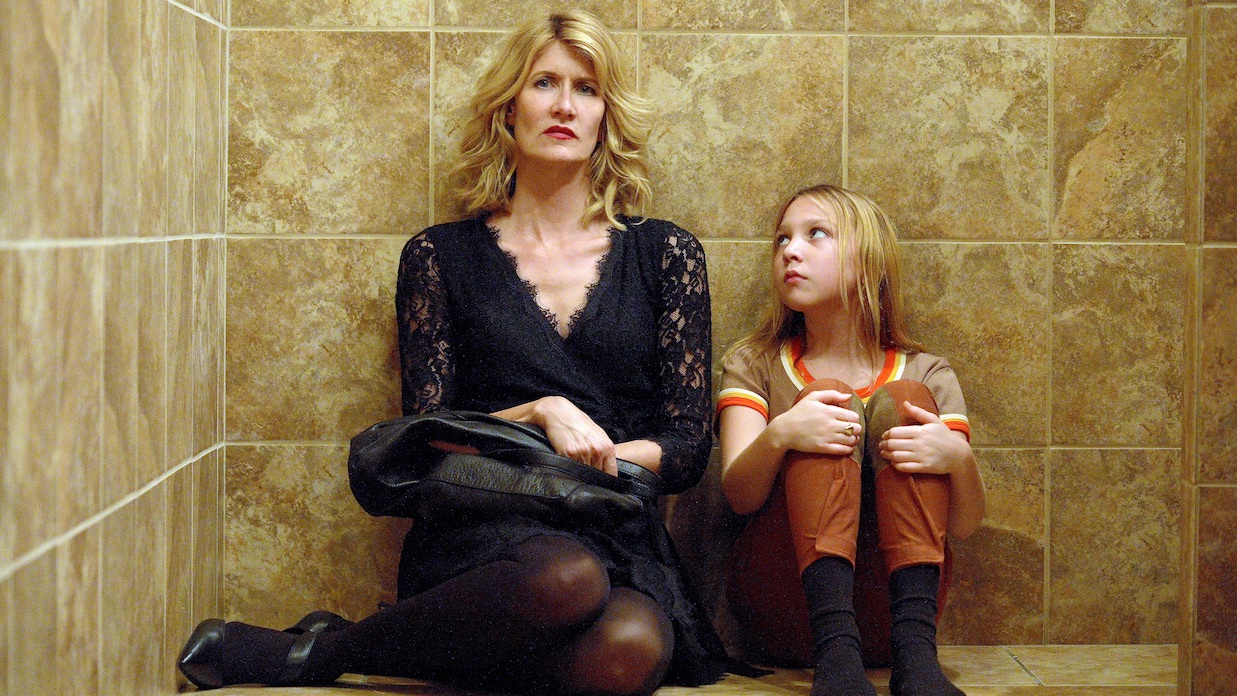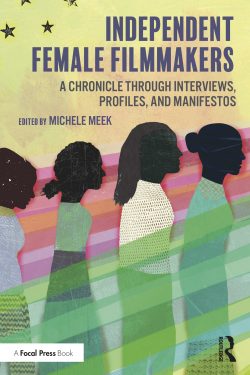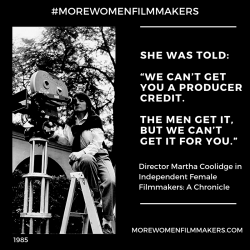Preserving the Legacy of Female Filmmakers and The Independent

Michele Meek, editor of the recently published book Independent Female Filmmakers, and Emily Watlington, who contributed a chapter on Ericka Beckman, discuss gender and filmmaking.

Michele Meek, editor of the just-released Independent Female Filmmakers: A Chronicle through Interviews, Profiles, and Manifestos (Routledge) sat down with Emily Watlington, a critic and curator who contributed a chapter on Ericka Beckman to the book. Independent Female Filmmakers recounts the legacy of 15 groundbreaking female filmmakers from Deepa Mehta to Cheryl Dunye to Martha Coolidge, while also highlighting the history of The Independent itself. Each chapter follows a then-and-now approach, with a filmmaker interview or manifesto originally published in The Independent, alongside a new filmmaker profile, interview, and/or manifesto.
On the occasion of the book’s release, Meek and Watlington discuss how gender affects what we value in film; the obstacles women filmmakers face; and the need for critics, curators, and teachers to turn to more eclectic bodies of work in order to include marginalized voices.
Emily Watlington: The book takes a then and now approach: you’re pairing historic interviews from The Independent Film & Video Monthly with new ones, and all of the filmmakers are born in the ’50s, ’60s, and ’70s [The Independent was founded in 1976]. Did any patterns stand out in this then and now comparison? To put it bluntly, are things getting better? It’s hard to feel like it given this year’s Oscar nominations…
Michele Meek: There was a widespread sentiment expressed by the women in the book that they really hoped things were getting better. Some of them expressed that in their early careers, they didn’t actually recognize some of the discrimination that they were facing. It was only later, on reflection, that they were surprised that they didn’t see it. Martha Coolidge has a quote at one point where she says, “it’s nice to know that I, too, lived in the illusion of ‘you can do anything you want.’” Lisa Cholodenko too talks about how earlier in her career she was put off by the question, “what’s it like to be a woman filmmaker?” because she felt that it was stigmatizing or limiting. She wanted to be a great filmmaker—why should it matter that she was a woman? But she says that now as we’ve started to talk more openly about harassment and discrimination, there’s more awareness around that question. It’s not just about why are you in this niche? It’s more about why have so many filmmakers been cast aside?
Watlington: That makes sense. Because when you see the pattern, you might think, oh maybe it is because I am a woman.

Meek: Right, and I think that becoming a filmmaker is a difficult career choice with so many obstacles anyway that a lot of the women filmmakers were not surprised to encounter obstacles. It seemed like, of course it’s hard to make a career as a filmmaker. So at the time they thought, maybe it’s not hard just because you’re a woman. But then on later reflection, seeing how some of their male counterparts were able to get so much further in their careers than they were, there was more acknowledgement of, wow, that really wasn’t right.
You look at someone like Martha Coolidge who directed films like Valley Girl and Real Genius. It’s easy to imagine that if she weren’t a woman, that she wouldn’t have been a major motion picture director in Hollywood with a very stable career after those two films. Many of the filmmakers talk about how difficult it is for women to fail. A female filmmaker who had a hit but then a bomb would be done for, while one good or even not so successful film might propel a male filmmaker forward.
Wes Anderson was discovered as a result of his short film Bottle Rocket, which was at Sundance and starred Owen Wilson and Luke Wilson, who were clearly talented actors. But the studio gave them an enormous amount of leeway and time to develop a feature out of that short. I think they had over a year on a studio lot to write. They then released the feature film Bottle Rocket and at the time, it was really a commercial and critical failure. Any female filmmaker who had had that trajectory—not only would she not have been given a year on a studio lot to write whatever she felt like writing, she would have never been given another chance after that kind of failure. I actually love Bottle Rocket, but you get my point. Women who had success didn’t even get second chances.
Anther pattern that emerged is how women-directed films are seen by critics and the academy. I talk about that in the introduction: a lot of women mention how that has been an obstacle. Miranda July talks about how her films have been seen as personal, even though they’re not. There are critics who call her work “twee,” and other comments that would never be said if she were a male filmmaker.
Watlington: I’ve definitely seen this. I reviewed Adina Pintilie’s Touch Me Not, which got a lot of backlash for being indulgent and sentimental by male critics, but I just felt like, no, it’s just not revolving around the sexuality of straight, able-bodied men.
Meek: It’s really interesting to hear who male filmmakers’ role models are too; rarely are they women. That’s a problem. It’s hard for people to see their own privilege and biases, unfortunately. I’ve realized this as I’ve been putting myself out there more on Instagram promoting women-directed work and receiving backlash from white men who really think discrimination doesn’t exist. When I posted about the Oscars, one commented, “well isn’t it just the best films?” and tried to suggest that no one removed a film from the list simply because it was directed by a woman. But that’s not at all the point I’m making.
Watlington: Right. The jury might not be conscious of who is making a film, but still, our culture privileges masculinist values.
Meek: Exactly. That’s the thing that’s harder to see. Why is one film about this particular subject, or with this kind of focus, or this type of story structure, less valued than this other type of story? There’s a reason for that. It’s just hard to see.
Watlington: I’m curious about some factors that went into your selection of filmmakers.
Meek: It was very difficult. To say it was an objective task to choose the filmmakers in this book would be false. I had my own preferences and biases clearly. As you recall, when we were trying to put together the list, I initially thought we wouldn’t be able to include a chapter on Ericka Beckman. Your pushback on that, questioning my decision to cut someone who had already been cut in so many different arenas, and how work like that tends to be cut, really was a helpful wake-up call. I wanted to try to be inclusive without really being able to fit everyone.
In general, I tried to narrow it down to women directors whose work still resonates today. In some cases, this made a hard sell for the filmmakers, because some of them weren’t working as filmmakers any more. For example, Maria Maggenti, who I see as a very instrumental filmmaker because she made the film Incredibly True Adventure of Two Girls In Love, which was one of the first positive coming-of-age lesbian stories, had really switched her career to being a television writer after meeting funding obstacles as a director. Yet I felt it was important to include her because her work still resonates today, and we should still be talking about and teaching that film. That was a big part of my motivation for choosing people: is their work still something we should be talking about, teaching, writing about, etc.?
Ericka was a perfect example of that, because her films had been marginalized throughout her career. And yet there’s been a new discovery of her career in the art world now.
Watlington: Right, so she’s made her films as installations. And they’re great!
Meek: But it’s still like, how does she fit into an independent female filmmakers collection? So I took that term a little bit loosely, to include people whose work remains relevant.
Watlington: That’s a point I really love from your introduction, that to be more inclusive of female filmmakers is to necessarily be more inclusive of these more eclectic bodies of work. Rather than only feature-length films in a signature style, also shorts, web series, performances, television series, installations. For me, as someone who writes on video art, this is a big motivating factor for what I do, especially in the ’70s and ’80s: many women who would have been influential feature filmmakers didn’t have budgets, and made what is now considered DIY, even avant-garde, which they were, but often by necessity.
I’m curious if you have more thoughts on these categories, like “video art,” and how they could inadvertently marginalize people’s work.
Meek: I think it absolutely does. Even the idea of romantic comedies…
Watlington: and melodrama!
Meek: Right. Genres intended for women audiences are often seen as less serious works of art. Everywhere you look—independent film, art film—you still find the same level of discrimination. Ericka talks about how, early on in her career in the experimental film world, people only thought of Stan Brakhage, etc. They weren’t always incorporating women filmmakers into what was seen as lasting or important work. We really need to reflect on A) how we’ve built those kind of categories, but also B) maybe even more importantly, who is considered great in those categories. Because no matter what category you go to, no matter how obscure it seems to be, you’re still finding that white men are considered the “heroes” of that genre.
Watlington: I just saw a documentary on Pauline Kael [What She Said], the female film critic, and she was saying that women in the arts and in film are doing quite well as muses and actresses. But for her, as a critic, allowing space for women to reason and make arguments is when men start to get scared and want to hold their power. She’s interesting; she’s actually a quite well-respected critic—a staff writer at the New Yorker—but she still never made a living wage from her work. This was only a small footnote in the film that was really profound to me, and really discouraging.
Meek: So even critics!
Watlington: Right, who are the sort of “taste-makers.”
Meek: And you look at something like the University of Mississippi Press collection that I critique in my introduction: 108 films and 7 of them are women. The curator of the collection is Gerald Perry, who is an older white male. When I reached out to him, he was not very receptive, which is unfortunate. This is what I mean about not seeing our biases. It’s in all of us—I have biases too. In the collection, I talk about how, years ago, when I was interviewed about Boston filmmakers, I picked three white men as examples. When I rediscovered this article in my research, I realized—wow! I thought I had a relatively tuned feminist consciousness, if not race consciousness at that point. But I had to educate myself.
Watlington: Right, the thing is to be aware that there’s a systemic reproduction that privileges the same voices. So it’s our job: there are great films by women and people of color, but you might have to look harder because they’re not in your face.
Meek: Exactly. Look at the 100 best films by AFI. AFI is an organization that has a program to support women directors; supposedly they are actively trying to be champions of women filmmakers. But if you look on their website at the 100 best films of all time, I don’t think they list even one film directed by a woman. What is that telling us? What is that telling future filmmakers, film fans? It’s unbelievably frustrating and depressing. Like you said, look at the Academy Awards this year. No women were nominated for best director. Why is this happening, when there are clearly active contenders in this category? What are all the machinations that are keeping this work from really being able to be seen and appreciated in the way that it deserves to be?

Watlington: I’m interested in the idea that lack of access to resources are both a limit, and also double as a creative restraint. So Ericka’s films are often handmade props in a black box, which reads as a signature style. You talk about “independent” to mean low budget and DIY, but also “independent” as in excluded from the resources and the audience. One huge constraint has been that women lack access to time in the form of feature-length films, which I can’t help but thinking as analogous to man-spreading (taking up more room than is fairly his on the subway), or mansplaining (hogging space in a conversation). Has anything emerged as to what prevents women from making features?
Meek: Studies, like the one done by Annenberg, found that there are a number of reasons, and funding was a significant one. There were others, like family responsibilities: a stereotype that often limits what people think women can do, and one fathers don’t seem similarly impacted by. In the movie Half the Picture, several women talk explicitly about that issue, and how they have to prove themselves sometimes.
Another significant factor is the lack of mentoring; I think this is starting to improve some. Women have started to become more conscious that they need to mentor other women. Maria Maggenti talks about how, on the heels of Incredibly True Adventure of Two Girls In Love, she did get attention and interest, but when she started to have meetings, but she didn’t know how to conduct herself or play the game in order to get what she wanted. She had no guidance. So she was true to herself, but that may not have actually been the most effective method for getting what she wanted. Although you have to wonder if that has been true for male filmmakers; why don’t they have to conduct themselves in some kind of professional manner in order to be taken seriously? They don’t!
Watlington: That’s a good point. And also men see themselves represented among famous filmmakers, or are conditioned to be forward and ask for mentorship. There are also men like Woody Allen and so many others who have royally messed up, but people hold up a separation between their work and their actions, while women aren’t often allowed the same privilege.
Your introduction opens with the question, “independent by default or by choice,” which I really love. It questions whether independent cinema is a promise of freedom from Hollywood, or an exclusion from it: especially its resources and audiences. I see this as related to your other project, which is about consent puzzles, in that it asks, how do you know when you’re choosing something? Or even, what is freedom or independence? Does that resonate?
Meek: Yes; I think that are choices are always constrained. They’re constrained by a great deal of societal pressures, beliefs, and traditions. Why would someone choose to be independent? It’s about creative control, being able to make the film you want to make. The question is: how often are some people allowed to make the kinds of films they want in a Hollywood system? I think when given an opportunity, almost every filmmaker is going to want more impact, more audience. There’s no one who says, “I’d like to keep my work in this little corner of the world where not that many people see it.”
Watlington: Or, “where I have to fundraise.” “Independent” is a hilarious word when you put it that way.

Meek: Not all of the filmmakers talk about the discrimination that they faced. Someone like Barbara Kopple, for instance, received an enormous amount of mentoring from the Maysles brothers and early on she took charge, learned how to do everything, and was able to assert herself. I think because she was in the documentary arena, perhaps she was able to make a lot more headway than some of the fiction filmmakers. The other one who doesn’t really acknowledge much discrimination is Deepa Mehta. She’s an Indian filmmaker who made films in Canada; her more positive experience may also have something to do with the Canadian system. She didn’t get funding always from the Canadian government, but she did get funding from the local government. I think there was less of a shock of her being a filmmaker in Canada than there is in the U.S. Those are two filmmakers out of the 15—and they don’t say that discrimination doesn’t exist, they acknowledge it and recognize that it’s been a problem, but they don’t feel personally that it’s hindered their careers. And you know, Deepa Mehta has had an Oscar-nominated film and Barbara Kopple has two Oscar awards. These are two filmmakers that, maybe because they’ve reached the same level of success that male filmmakers can, don’t feel it has affected them as much.
Watlington: It’s curious to know if discrimination didn’t hinder their success, or if they didn’t experience it visibly in their day-to-day, or if they simply never identified it as that. And there’s no way for us to know. A lot of women, after #MeToo, had not previously thought of themselves as having ever been sexually harassed because it’s so normalized, but see it differently now.
Meek: Right. Natalie Portman recalled that, upon first hearing about #MeToo, she thought she didn’t have a story to tell. Then on further reflection, she realized, I have a hundred stories of sexual harassment in Hollywood to tell. It had become so embedded into her everyday experience that she didn’t see it at first.
Watlington: Exactly. And that gets back to how things get internalized, and then the paradox of “independence” that your book is about!
The book Independent Female Filmmakers is available for order via Routledge and Amazon. To learn more about Michele Meek visit her website at michelemeek.com.
Regions: California, New York, New York City
